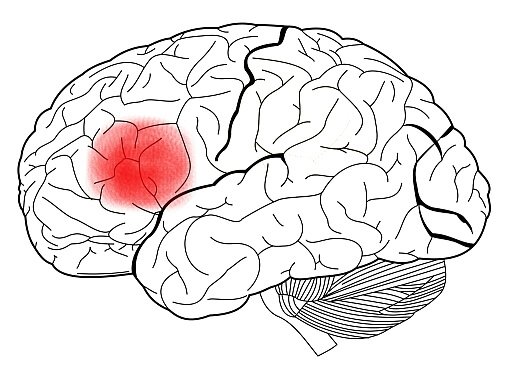The Broca Area and Language Production

One major aspect of our neurological ability to produce language is that it’s one-sided. In other words, most of the brain structures related to language are in our brain’s left hemisphere.
But some studies say that things like jokes, pragmatism, and sarcasm come from the right hemisphere. Still, the Broca area (or Broca’s area), which deals with language production, is in the left hemisphere. More specifically, it’s in area 44, according to the theory of Brodmann areas.
In this article we’re going to tell you about two basic things you have to know to understand what role the Broca area plays in language. The first are its anatomical and functional aspects. The second has to do with Broca’s aphasia, which comes from damage to the area.
The anatomy and functioning of the Broca area
As time has gone by we’ve started to realize that the Broca area isn’t the only area involved in language production. Along with Broadman area 44, areas 45, 47 and a large part of area 6 also play a big role. That’s why it would be more accurate to call it the Broca system.

There’s also a subdivision of the Broca system into two large structures: the triangular and opercular. The triangular structure is in the frontal part of the Broca area, and the opercular structure is in the back.
On an anatomical level, this system is closely linked to Wernicke’s area. Wernicke’s area plays the main role in understanding language. These two areas (Wernicke’s and Broca’s) are connected by a bundle of neurons called the arcuate fasciculus.
Here are the Broca area’s functions:
- Verbal behavior production, both speech and writing.
- Managing graphemes, phonemes, and words to structure grammar and morphology.
- Coordination of the speech organs to regulate pronunciation.
- Regulation of prosody, tone of voice, and rhythm of speech.
These functions are the pillars holding up our language production. They’re what make it so we can use language well enough to communicate. Hence, problems in the Broca area can have serious consequences in using language and communicating. In the next section we’re going to talk about the specific consequences of damage to this brain region.
Broca’s aphasia
Broca’s aphasia is a language production disorder that comes from damage to the Broca area. Symptoms include slow, forced, and non-fluid speech. But even though a person with this disorder has poor pronunciation, the message they’re sending usually makes sense. That’s how we’ve reached the conclusion that there are no semantic problems with Broca’s aphasia.

For anyone with Broca’s aphasia, it’s easier to say some kinds of words than others. For example, it’s harder for them to say functional words (an, the, some, above, of…) than ones with meaning.
The reason is basically that functional words only exist for the sake of grammar, and the Broca area plays a part in that. On the other hand, since their semantics are fine, meaningful words are easier for them to say.
Another key aspect of Broca’s aphasia is that language comprehension skills remain intact. People with this disorder have no trouble reading or listening to someone talk. Wernicke’s area is the brain structure that deals with this neurological process.
It’s another fact that gives us confidence that the Broca area is mainly for language production. Even though it has connections to other areas, it seems that those keep on working like normal.
Lastly, there’s a strange process that happens when you damage your brain’s language centers at an early age. Our brain’s are incredibly plastic. Therefore, if you damage your left hemisphere, language might develop in your right hemisphere instead.
In other words, brain damage before language is fully developed isn’t the end of the world. Your brain shifts things around so that you can develop normally, or almost normally.
One major aspect of our neurological ability to produce language is that it’s one-sided. In other words, most of the brain structures related to language are in our brain’s left hemisphere.
But some studies say that things like jokes, pragmatism, and sarcasm come from the right hemisphere. Still, the Broca area (or Broca’s area), which deals with language production, is in the left hemisphere. More specifically, it’s in area 44, according to the theory of Brodmann areas.
In this article we’re going to tell you about two basic things you have to know to understand what role the Broca area plays in language. The first are its anatomical and functional aspects. The second has to do with Broca’s aphasia, which comes from damage to the area.
The anatomy and functioning of the Broca area
As time has gone by we’ve started to realize that the Broca area isn’t the only area involved in language production. Along with Broadman area 44, areas 45, 47 and a large part of area 6 also play a big role. That’s why it would be more accurate to call it the Broca system.

There’s also a subdivision of the Broca system into two large structures: the triangular and opercular. The triangular structure is in the frontal part of the Broca area, and the opercular structure is in the back.
On an anatomical level, this system is closely linked to Wernicke’s area. Wernicke’s area plays the main role in understanding language. These two areas (Wernicke’s and Broca’s) are connected by a bundle of neurons called the arcuate fasciculus.
Here are the Broca area’s functions:
- Verbal behavior production, both speech and writing.
- Managing graphemes, phonemes, and words to structure grammar and morphology.
- Coordination of the speech organs to regulate pronunciation.
- Regulation of prosody, tone of voice, and rhythm of speech.
These functions are the pillars holding up our language production. They’re what make it so we can use language well enough to communicate. Hence, problems in the Broca area can have serious consequences in using language and communicating. In the next section we’re going to talk about the specific consequences of damage to this brain region.
Broca’s aphasia
Broca’s aphasia is a language production disorder that comes from damage to the Broca area. Symptoms include slow, forced, and non-fluid speech. But even though a person with this disorder has poor pronunciation, the message they’re sending usually makes sense. That’s how we’ve reached the conclusion that there are no semantic problems with Broca’s aphasia.

For anyone with Broca’s aphasia, it’s easier to say some kinds of words than others. For example, it’s harder for them to say functional words (an, the, some, above, of…) than ones with meaning.
The reason is basically that functional words only exist for the sake of grammar, and the Broca area plays a part in that. On the other hand, since their semantics are fine, meaningful words are easier for them to say.
Another key aspect of Broca’s aphasia is that language comprehension skills remain intact. People with this disorder have no trouble reading or listening to someone talk. Wernicke’s area is the brain structure that deals with this neurological process.
It’s another fact that gives us confidence that the Broca area is mainly for language production. Even though it has connections to other areas, it seems that those keep on working like normal.
Lastly, there’s a strange process that happens when you damage your brain’s language centers at an early age. Our brain’s are incredibly plastic. Therefore, if you damage your left hemisphere, language might develop in your right hemisphere instead.
In other words, brain damage before language is fully developed isn’t the end of the world. Your brain shifts things around so that you can develop normally, or almost normally.
All cited sources were thoroughly reviewed by our team to ensure their quality, reliability, currency, and validity. The bibliography of this article was considered reliable and of academic or scientific accuracy.
- Castaño, J. (2003). Bases neurobiológicas del lenguaje y sus alteraciones. Rev Neurol, 36(8), 781-5.
- del Río Grande, D., & Sánchez, R. L. H. (2003). Especifidad del área de Broca en la comprensión de oraciones. Revista de Logopedia, Foniatría y Audiología, 23(3), 154-163.
- Trejo-Martínez, D., Jiménez-Ponce, F., Marcos-Ortega, J., Conde-Espinosa, R., Faber-Barquera, A., Velasco-Monroy, A. L., & Velasco-Campos, F. (2007). Aspectos anatómicos y funcionales sobre el área de Broca en neurocirugía funcional. Revista médica del hospital general de México, 70(3), 141-149.
This text is provided for informational purposes only and does not replace consultation with a professional. If in doubt, consult your specialist.







